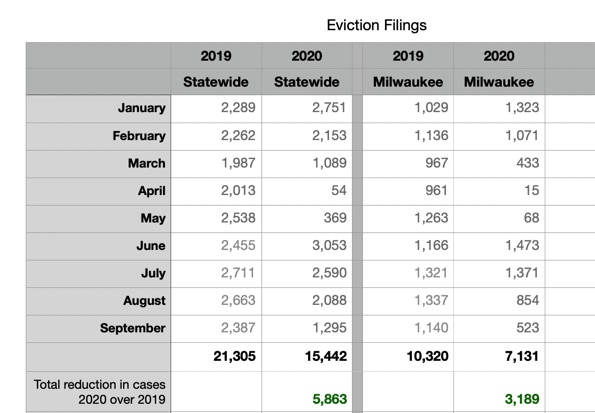How do landlords think unemployed people will pay rent?:
…an average of 8% of renters don’t pay rent in normal times. During the coronavirus crisis to date, that share has gone up to 15 to 20% of renters not paying.
“But generally, I think we need a better approach instead of just pitting owners versus tenants,” he says. Both the tenants and landlords need some larger, holistic fix from the government that acknowledges that there just isn’t as much money flowing through the system as there should be.
Nearly 12 million renters will owe an average of $5,850 in back rent and utilities by January, Moody’s Analytics warns. Last month, 9 million renters said they were behind on rent, according to a Census Bureau survey.
The over $70 Billion in unpaid rent, as reported by Moody’s will cripple many housing providers and will cause a housing crisis that will impact both tenants and municipalities for years, if not decades. In May of 2020 Milwaukee property values finally recovered from the 2008 Great Recession.
Less than 2.5% of rent judgments are paid in Milwaukee County five years after the eviction. And eviction judgments represent only a small fraction of the unpaid rent. In surveying owners, we see on a high end 42% of their lost rent is included in eviction judgments, with most owners reporting less than 10%. Some owners never pursue money judgments. So the million dollars a month in eviction judgments represent somewhere between $28.5 million to $100 million a year in money that should go into housing but does not. I peg the number at least to be $48 Million a year in lost rent in one county. This is just insane.
The right answer is for the government to step up to the plate and create a portable housing voucher to cover a portion, to all, of the rent /housing costs for people below a certain income, similar to food stamps.
Instead, the government pits tenants against landlords in a zero-sum game where one must lose for the other to win. In the end, this makes housing more expensive or limits choices.
This has been a problem long before COVID. In 1991 I was interviewed by the New York Times on evictions. I asked the reporter, “On $574 a month, how do you buy tennis shoes for the kids, clean shirts for school, and still pay your rent?” Nothing has changed much since then. $574 was the AFDC (now W2) payment amount. Twenty years later in an NYT interview, my comment was basically the same:
“On $673 a month, how do you buy tennis shoes for the kids, clean shirts for school and still pay your rent?” Mr. Ballering said.”
https://www.nytimes.com/2010/02/19/us/19evict.html
Some suggest canceling mortgages and rents, thinking that this equivalent and will prevent the economic failure of housing. Sadly, it will not.
The average mortgage payment is 36-39% of gross income. The average owner earns 7-9% of gross income for their investment of capital, financial risks, and physical efforts. If you stop mortgage and rent payments, as well as prevent owners from being paid for their investment and efforts, there is still 52-57% of gross rent that is needed to cover other operating costs such as sewer, water, property taxes, maintenance, insurance, etc.
In Milwaukee, for most properties, the City takes a far bigger cut of the rent in property taxes, and sewer/water bills, than the owner gets to keep.
If you read the Brookings report, you will see this plus the “local economic multiplier” effect of wages and other monies expended by owners.
The Census Bureau reported in 2018 that, on average, every unit generates almost $1,200 in wages. Those wages, the property tax money, etc, circulate throughout the community many times over.
Here’s what scholars believe will happen if there is a moratorium without rental assistance; https://papers.ssrn.com/sol3/papers.cfm?abstract_id=3641859 It goes into the economic impact on housing and the cost borne by other current and future tenants. It is an informative read.




